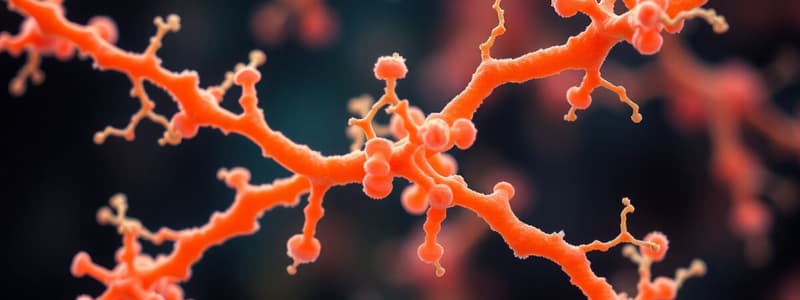Podcast
Questions and Answers
What percentage of cellular mass is typically made up of water?
What percentage of cellular mass is typically made up of water?
- 50%
- 30%
- 70% or more (correct)
- 90%
Which property of water allows it to form hydrogen bonds with other polar molecules?
Which property of water allows it to form hydrogen bonds with other polar molecules?
- Low molecular weight
- Polarity (correct)
- High viscosity
- High density
Which of the following sugars is classified as a triose?
Which of the following sugars is classified as a triose?
- Ribose
- Glyceraldehyde (correct)
- Starch
- Glucose
Which type of molecules are considered hydrophilic?
Which type of molecules are considered hydrophilic?
What is the primary carbon linkage in glycogen?
What is the primary carbon linkage in glycogen?
What is the main reason nonpolar molecules cluster together in water?
What is the main reason nonpolar molecules cluster together in water?
Why are polar and nonpolar interactions important in biological structures?
Why are polar and nonpolar interactions important in biological structures?
Which sugar forms a ring structure in both α and β configurations?
Which sugar forms a ring structure in both α and β configurations?
Which of these is considered a pentose?
Which of these is considered a pentose?
What distinguishes trioses from hexoses?
What distinguishes trioses from hexoses?
What type of polysaccharide is characterized by a linear, non-branched structure?
What type of polysaccharide is characterized by a linear, non-branched structure?
Which glycosidic bond connects the glucose molecules in both glycogen and amylose?
Which glycosidic bond connects the glucose molecules in both glycogen and amylose?
Which polysaccharide primarily serves as a storage form of glucose?
Which polysaccharide primarily serves as a storage form of glucose?
What structural characteristic distinguishes glycogen from amylose?
What structural characteristic distinguishes glycogen from amylose?
What is the main function of cellulose in plants?
What is the main function of cellulose in plants?
What is the primary role of simple sugars like glucose in cells?
What is the primary role of simple sugars like glucose in cells?
Which statement about polysaccharides is correct?
Which statement about polysaccharides is correct?
What type of bond forms between monosaccharides?
What type of bond forms between monosaccharides?
Which of the following chains of sugars is referred to as oligosaccharides?
Which of the following chains of sugars is referred to as oligosaccharides?
Which of the following is an accurate representation of the basic structure of carbohydrates?
Which of the following is an accurate representation of the basic structure of carbohydrates?
Which statement about the structure of polysaccharides is correct?
Which statement about the structure of polysaccharides is correct?
What role do oligosaccharides play in cellular functions?
What role do oligosaccharides play in cellular functions?
Which characteristic is NOT true for glycogen and starch?
Which characteristic is NOT true for glycogen and starch?
What are the primary functions of lipids in cells?
What are the primary functions of lipids in cells?
What type of glycosidic bonds are primarily found in cellulose?
What type of glycosidic bonds are primarily found in cellulose?
Flashcards
Water in Cells
Water in Cells
Water makes up the majority of a cell's mass, about 70% or more.
Water's Polarity
Water's Polarity
The uneven distribution of charge in a water molecule, with the oxygen end slightly negative and the hydrogen ends slightly positive.
Hydrogen Bonds
Hydrogen Bonds
Interactions between water molecules due to their polarity, where the slightly positive end attracts the slightly negative end.
Hydrophilic
Hydrophilic
Signup and view all the flashcards
Hydrophobic
Hydrophobic
Signup and view all the flashcards
Simple Sugars: Cell Fuel
Simple Sugars: Cell Fuel
Signup and view all the flashcards
Polysaccharides: Sugar Chains
Polysaccharides: Sugar Chains
Signup and view all the flashcards
Glycosidic Bond
Glycosidic Bond
Signup and view all the flashcards
Oligosaccharides: Short Sugar Chains
Oligosaccharides: Short Sugar Chains
Signup and view all the flashcards
Glycogen vs. Starch
Glycogen vs. Starch
Signup and view all the flashcards
What is glucose?
What is glucose?
Signup and view all the flashcards
What are the anomeric forms of glucose?
What are the anomeric forms of glucose?
Signup and view all the flashcards
What is glycogen?
What is glycogen?
Signup and view all the flashcards
What is starch?
What is starch?
Signup and view all the flashcards
What is a 1,4 glycosidic bond?
What is a 1,4 glycosidic bond?
Signup and view all the flashcards
What are polysaccharides?
What are polysaccharides?
Signup and view all the flashcards
How are glucose units linked in polysaccharides?
How are glucose units linked in polysaccharides?
Signup and view all the flashcards
What makes cellulose strong?
What makes cellulose strong?
Signup and view all the flashcards
What is the role of oligosaccharides and polysaccharides in cell signaling?
What is the role of oligosaccharides and polysaccharides in cell signaling?
Signup and view all the flashcards
What are the key functions of lipids in cells?
What are the key functions of lipids in cells?
Signup and view all the flashcards
Glycogen - What is it?
Glycogen - What is it?
Signup and view all the flashcards
Starch - What is it?
Starch - What is it?
Signup and view all the flashcards
Cellulose - What is it?
Cellulose - What is it?
Signup and view all the flashcards
What is a (1→4) glycosidic bond?
What is a (1→4) glycosidic bond?
Signup and view all the flashcards
What is a (1→4) glycosidic bond?
What is a (1→4) glycosidic bond?
Signup and view all the flashcards
What are (1→6) glycosidic bonds?
What are (1→6) glycosidic bonds?
Signup and view all the flashcards
How are glycosidic bonds broken?
How are glycosidic bonds broken?
Signup and view all the flashcards




